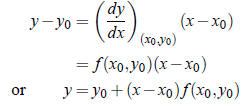SKEDSOFT
Euler's Method:
First Order Differential Equations:
Consider the differential equation;

where y(x0) = y0.
Suppose that we wish to find successively y1, y2, ..., yn where ym is the value of y corresponding to x = xm, where xm = x0 mh, m = 1, 2, ...,h being small. Here, we use the property that in a small interval, a curve is nearly a straight line. Thus, in the interval x0 to x1 of x, we approximate the curve by the tangent at the point (x0, y0). Therefore, the equation of tangent at (x0, y0) is;

Hence, the value of y corresponding to x = x1 is

Since the curve is approximated by the tangent in [x0, x1], Equation above gives the approximated value of y1.
Simialrly, approximating the curve int he next interval [x1, x2] by a line through (x1, y1) with slope f (x1, y1), we get;

Proceeding on, in general it can be shown that

Simultaneous First Order Differential Equations:
Euler’s methed can be extended to the solution of system of ordinary differential equations. The folowing example illustrates the procedure.
Example:  using Euler’s method, assuming that x = 0, y = 4,and z = 6. Integrate to x = 2 with h = 0.5.
using Euler’s method, assuming that x = 0, y = 4,and z = 6. Integrate to x = 2 with h = 0.5.
Solution: We have;

Euler’s formula is

